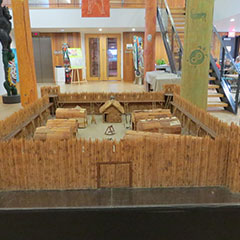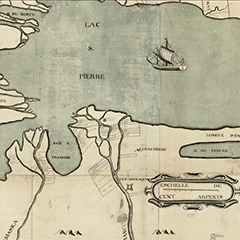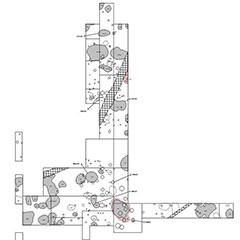An Archaeological Project and a Fort
In 2010, a team of archaeologists started working on the grounds of the Musée des Abénakis, in Odanak. They were looking for remains of the fortified village erected around 1704 on the banks of the nearby Saint-François River. Finding traces of this fortification would be a first in North America, from historical and archaeological standpoints. Not only was it the only fortification commissioned in the colony by Louis XIV, King of France, but it was built by a military contingent of French and Abenakis and inhabited by an Aboriginal population.
Prior to the fieldwork, the archaeologists had carefully studied old and recent maps, as well as historical sources that mentioned the presence of Abenakis at Odanak in the early colonial period. They then did an archaeological survey of several parts of the site to find underground clues to the former presence of the fort. The scientific approach adopted for this important archaeological project, called Fort Odanak: the Past Revisited, lived up to expectations: archaeological remains associated with the fortified village were uncovered during the four field seasons.
Download video: MP4, (42,19 MB), WebM, (42,67 MB), Ogg (31,63 MB) (4 minutes 48 seconds)
Transcription
Geneviève Treyvaud: My name is Geneviève Treyvaud. I’m an archaeologist specializing in the contact period, or the period when Europeans and Amerindians first came into contact with each other. The idea took shape in 2005. Much of my work is on Aboriginal peoples of the east, namely, the Abenakis, Micmacs and Malecites. It was the fortification dating from 1704 that first caught my interest. We found a map of the fort and were able to get hold of a copy of it. We then tried to see where the fort might have been located on the Saint-François River by superimposing a few maps. Then, in 2011 – in October 2011 – we began to do research here, on this plateau, in what is called the Odanak historic district, and that is where we saw... we started to find structural remains and artifacts dating from the period of the fort, or the early 18th century.
G.T.: We began to do open-area excavations this summer, in 2012. Our most interesting discoveries so far are obviously the post holes that lead us to believe we are very close to the palisade and interior of the fort. We would really like to find the remains of the first church. We think that we may have a masonry wall over there but, for now, we’re still not ... we still don’t have the rest of the church.
G.T.: As for artifacts, we found something that has inevitably helped a lot. It’s a coin that dates from... a French liard that dates from 1657. We’ve also uncovered a lot of tinkling cones, which are typical of the period. In fact, we’ve found hearths where copper was worked. They took copper kettles and cut them into pieces. So we found pieces of kettles, pieces of copper, which were shaped into cones that were used to make a kind of bell that could be attached to clothing and hair. We also found trade beads, so we know that furs were traded inside the fort.
G.T.: The dig will continue next summer, for one more field season, and then we’ll hold an exhibition. The exhibition will deal not only with the archaeology project but also with the educational one, which has enabled young Abenakis to work on the excavation team with students from Université Laval.
Michelle Bélanger: Adding a community component to the project’s scientific component was very important to us. The goal was to ensure that people from the community would take ownership of the project, and the best way to do that was to take young people on as apprentice archaeologists. Seven young people from the community were already working with us during the first week of the project, the first week of training starting July 3. Archaeologists gave them theoretical training that week so that they would know how to dig, as well as training in iconography and material culture so that they could identify the objects they found.
M.B.: They’re discovering their culture, history, heritage and roots through this project. As soon as they find an object, we explain what it was used for, and they can then really imagine how their ancestors lived. Another equally important aspect of the project is that, for the first time, scientists aren’t coming to Odanak to simply study the community’s past and leave with the information they have gathered.
G.T.: All the material culture, or the archaeological assemblage, we have uncovered, namely, the objects, etc., will be back here in the spring for an exhibition. And we should be back here in May – as of May – to start digging again.
M.B.: By following the archaeology project on our website, people can find out what’s happening on the dig every day. And during the winter, they’ll be able to learn about the research work that archaeologists do. I invite everyone to come and see the team at work as they look for Fort Odanak, and to keep track of the museum’s activities online.



